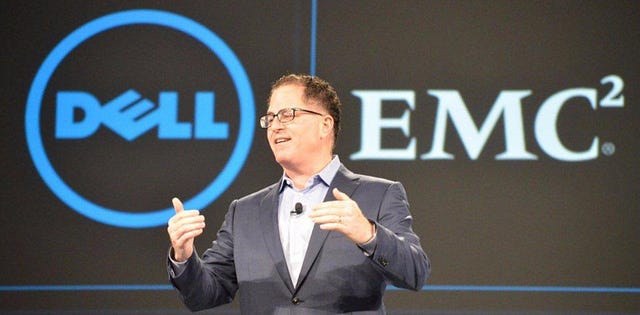Sizing Up the Dell-EMC Merger, One Year Later
The combined company faces challenges in a rapidly evolving infrastructure market.
December 14, 2017

Still the biggest merger in the IT industry to date, Dell's acquisition of EMC was the union of a server empire and a storage kingdom. On the surface, the market synergies of the joined pair far outweighed the product overlaps. It's been more than a year since the deal was finalized and it's time to check see if it has lived up to its promise.
Bear in mind that the acquisition was a response to the changing demographics of the industry, basically to defend against the race to the bottom in systems hardware as IT continues to migrate to the cloud. Simply put, cloud service providers buy gear in huge volumes from original design manufacturers typically in Taiwan or China, at much lower prices.
These commercial off-the-shelf units are becoming mainstream amid a recognition that they are functionally the same as more expensive units from long-established brands. This cheap equipment has helped create an “internet-priced” approach to buying SSDs and hard drives. For example, the list price of an EMC drive can be as much as 14X the price of one from online distributor Arrow Electronics.
The bottom line is that both companies, and perhaps especially EMC, saw the writing on the wall. The decline of hardware revenue will take a few years, but it's inevitable. With this as background we can consider whether the union of the companies, now called Dell Technologies, is a success.
Financial performance
The obvious first place to look is financial. Tom Sweet, the CFO of Dell Technologies, handled the bookkeeping merger very well indeed. Decision-making has been wisely delegated as much as possible, which should make for a lean and agile company going forward.
What are the results so far? Dell Technologies closed its 2017 fiscal year in March with $62 billion in revenue (with 53 days of EMC not included) and in the second quarter of fiscal year 2017, it posted posted $19.3 billion, looking good. Dell carries a high debt burden from the acquisition, but has paid down $9.6 billion already, including selling off its service/software operation for $5.3 billion. The company's third-quarter results are also strong on the revenue side at $19.6 billion, but while cash flow is $1.6 billion, it lost $533 million. Cash is king, obviously, but this shows that a lot of work still remains to make the combined entity cost efficient.

Michael Dell.jpg
There are some red flags on the fiscal horizon. The company grew only $34 million year over year in total enterprise storage sales, losing market share in the process. HPE has a small lead, but also lost share. The big winner was the ODM segment with collectively the largest revenue and a whopping 55% gain in market share, which seems to add credence to those fears that triggered the union of the companies. Server sales mirror this, though there is less of a growth gap with ODMs. In fact, it looks like the ODMs are in fact achieving the market penetration Dell and EMC feared and this is a long-term systemic change.
Technology challenges
The combined entity also faces some technical challenges. First, it still must consolidate overlapping storage systems. I expect one major move will be lowering the emphasis on RAID arrays, EMC’s signature product. All of the iSCSI product lines will need rationalization; there are just too many to allow the salesforce to be efficient, just like the auto industry with all of its brands back in the 1970s.
These changes imply a threat to internal engineering and marketing empires. It will be interesting to see how this plays out in a environment that's seeing the most change in four decades. Will protection of product families interfere with retooling the design effort to accommodate trends such as modular computers, hyperconvergence, and solid-state drive solutions?
Likely, we will see some strain between the established Dell units and the need to adopt new technologies, as already indicated by the number of OEM deals fueling new product areas Dell is pursuing, such as the partnership with hyperconvergence leader Nutanix. I would add, though, that Dell is nimble in the OEM space and appears to be signing up a deeper and more first-rate portfolio than its competitors.
The cloud
For all the traditional system vendors, the elephant in the room is the cloud. There is no question that IT is pulled to the cloud and that the percentage of IT run in the cloud will continue to increase. Dell and the others have so far not done well in competing with the ODMs for cloud sales to the top three cloud-service providers -- Amazon, Google and Microsoft -- and it’s unlikely they will penetrate the rapidly expanding Chinese cloud market either.
The reason is business cost models. Chinese ODMs run very lean indeed, without big planning staffs and minimum HR. Most of their R&D is based around reference designs from vendors such as Intel, rather than designing from scratch. The reality is that the traditional US suppliers such as HPE, Cisco and Dell have followed the cloud providers to the ODMs, which supply many parts to them, if not complete branded systems.
Dell will have to look to add value to what is a Chinese-sourced commodity server or storage appliance. This is a place for integration and support, and signals more rapid devaluation of the EMC side of the business, as proprietary RAID units are replaced with inexpensive COTS products.
About the Author
You May Also Like




